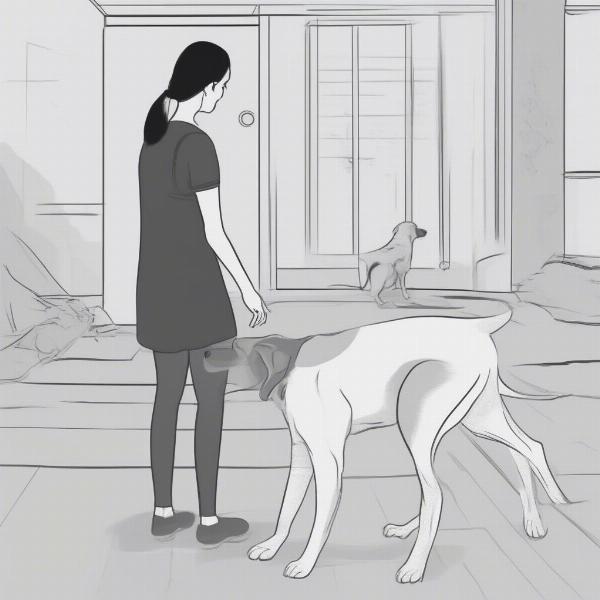An overstimulated dog can exhibit a range of behaviors, from excessive barking and jumping to destructive chewing and even aggression. Understanding how to calm an overstimulated dog is crucial for both your pet’s wellbeing and your own peace of mind. This article will provide practical tips and techniques to help you recognize the signs of overstimulation and guide your furry friend back to a relaxed state. We’ll explore everything from environmental management to specific calming activities, empowering you to create a harmonious environment for your canine companion.
Recognizing the Signs of an Overstimulated Dog
Is your dog panting heavily even though they haven’t been exercising? Are their pupils dilated, and do they seem unable to focus? These could be signs of an overstimulated dog. Other indicators include whining, pacing, excessive licking, tucked tail, and avoidance of eye contact. Recognizing these signs early is key to preventing a potential meltdown. A dog experiencing overstimulation is not being disobedient; they are simply overwhelmed and need your help to regain control.
Creating a Calm Environment for Your Dog
Managing your dog’s environment is one of the most effective ways to prevent overstimulation. Designate a quiet, comfortable space where your dog can retreat when they feel overwhelmed. This could be a crate, a dog bed in a quiet corner, or even a specific room. Ensure this space is free from distractions like loud noises, bright lights, and excessive activity. Providing predictable routines can also greatly reduce anxiety and overstimulation. Consistent feeding times, walks, and playtime help your dog feel secure and in control.
Calming Activities for an Overstimulated Dog
When your dog starts showing signs of overstimulation, engaging them in calming activities can help them de-stress. Gentle massage can be incredibly soothing for dogs. Start with slow, gentle strokes along their back and sides. If your dog enjoys it, you can gradually increase the pressure.
Another effective technique is to introduce calming scents. Lavender and chamomile are known for their relaxing properties and can be diffused in your dog’s environment or used in a diluted spray on their bedding. Always ensure the essential oils are pet-safe and appropriately diluted.
Training Techniques to Manage Overstimulation
Teaching your dog specific commands like “settle” or “quiet” can be invaluable in managing overstimulation. These commands provide a clear direction and help your dog focus on something other than the overwhelming stimuli. Positive reinforcement training methods, using treats and praise, are the most effective way to teach these commands. Consistency is key; practice these commands regularly, even when your dog is not overstimulated, to reinforce the desired behavior.
What to Avoid When Your Dog is Overstimulated
When your dog is overstimulated, avoid raising your voice or making sudden movements, as this can further escalate their anxiety. Similarly, avoid forcing interaction or petting them if they are showing signs of wanting to be left alone. Respect their need for space and allow them to retreat to their safe space. Punishing an overstimulated dog is counterproductive and can exacerbate the problem. Remember, they are not misbehaving; they are struggling to cope with sensory overload.
 Things to avoid when your dog is overstimulated
Things to avoid when your dog is overstimulated
Conclusion
Understanding how to calm an overstimulated dog is an essential part of responsible pet ownership. By recognizing the signs, managing their environment, and utilizing calming techniques and training, you can help your dog navigate overwhelming situations and enjoy a more relaxed and balanced life. Remember, patience and consistency are key. With your support and understanding, your furry friend can learn to manage their overstimulation and thrive in a variety of environments.
FAQs
- How can I tell if my dog is overstimulated or just excited? While excitement can involve some of the same behaviors, overstimulation often includes signs of stress like panting, dilated pupils, and avoidance.
- What are the most common triggers for overstimulation in dogs? Loud noises, unfamiliar people or animals, sudden changes in routine, and crowded environments are common triggers.
- Can overstimulation be a sign of an underlying medical condition? While overstimulation is often behavioral, it’s always best to consult with a vet to rule out any underlying medical issues.
- How long does it usually take for an overstimulated dog to calm down? This varies depending on the dog and the trigger, but with the right techniques, most dogs can calm down within a few minutes to an hour.
- Is it okay to leave my overstimulated dog alone? If your dog has a designated safe space, it’s generally okay to leave them alone to decompress. However, if they are exhibiting extreme signs of distress, it’s best to stay with them and provide support.
- Can puppies be more prone to overstimulation? Yes, puppies are still developing their coping mechanisms and are therefore more susceptible to overstimulation.
- What if my dog’s overstimulation leads to aggression? Consult with a certified professional dog trainer or veterinary behaviorist for guidance on addressing aggression related to overstimulation.
Related Articles
dog crate with cover
silent squeaker dog toys
About ILM Dog
ILM Dog (https://ilmdog.com) is your premier online resource for all things dog-related. We offer expert advice on dog breeds, health and medical care, training and behavior, nutrition, grooming, and much more. From choosing the right breed to providing the best possible care, ILM Dog helps you navigate every aspect of dog ownership. Whether you’re a seasoned dog owner or just starting out, we provide valuable insights and practical tips to enhance your relationship with your canine companion. Our expertise covers various aspects, from dog crate covers to silent squeaker dog toys, catering to a wide range of needs. Contact us today for personalized guidance on your dog’s health and well-being at [email protected] or +44 20-3965-8624.